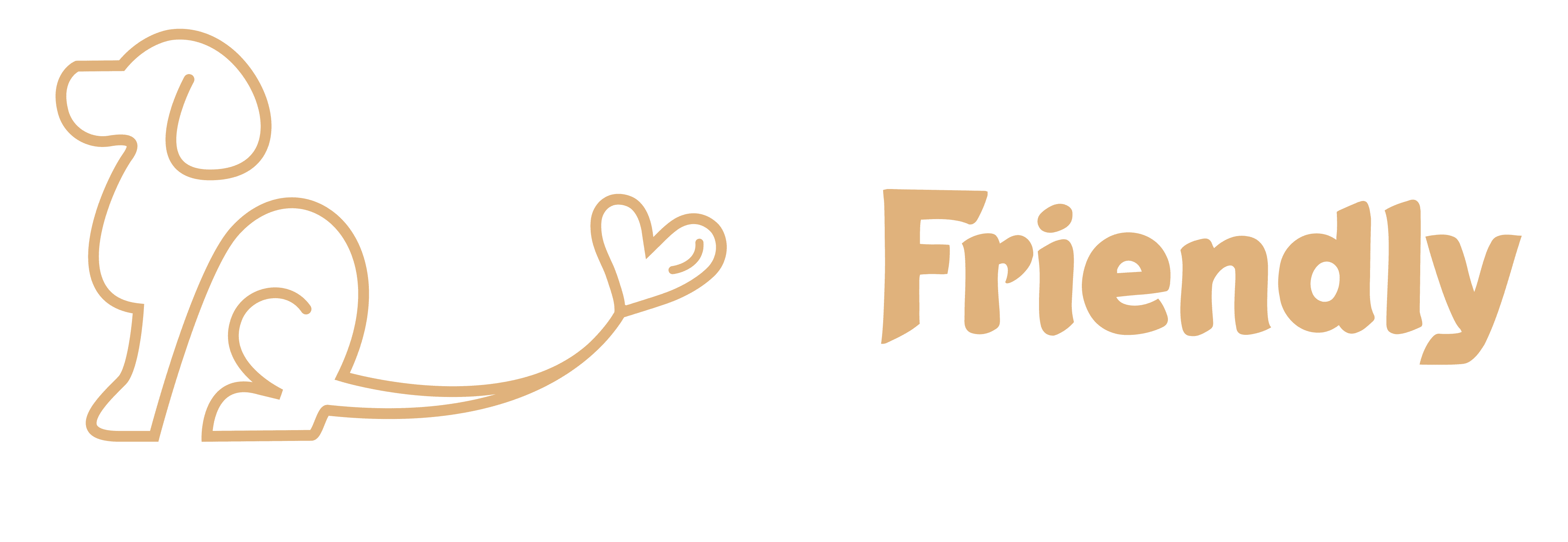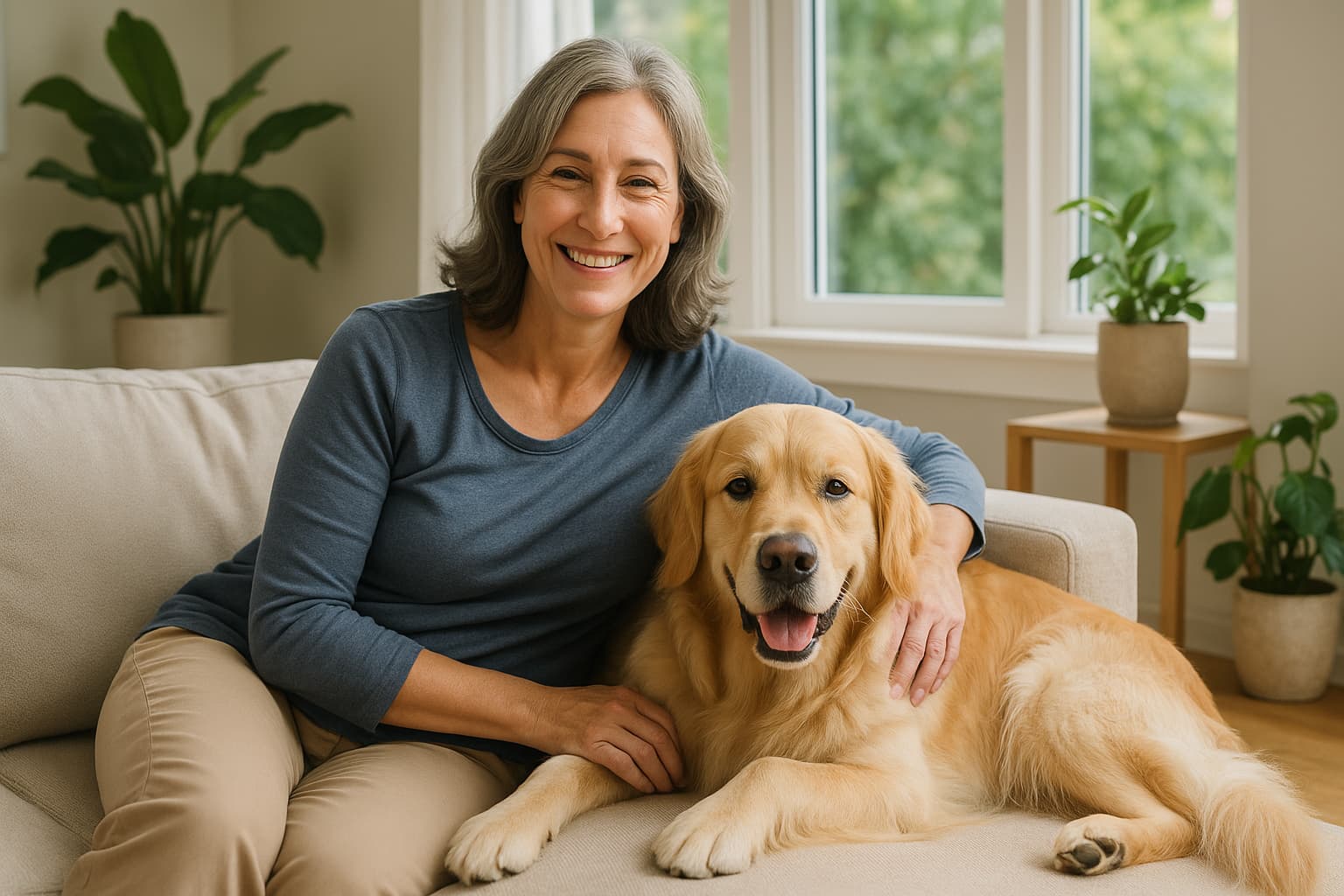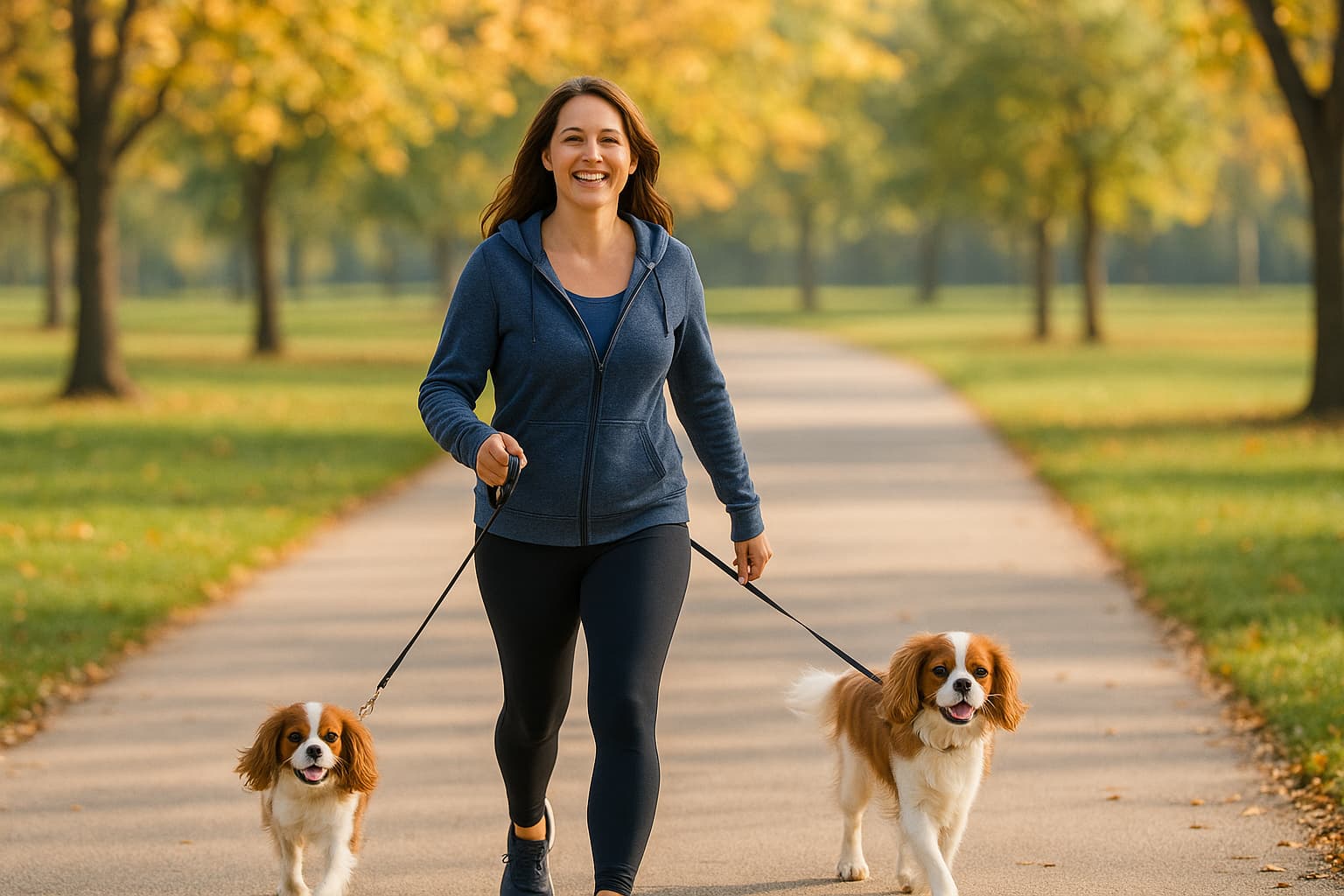Last Updated: October 2025
The transition into midlife brings profound changes for women—physically, emotionally, and socially. Between ages 45 and 60, many women experience a perfect storm of life transitions: children leaving home (empty nest syndrome),
hormonal changes, career pivots, aging parents, relationship shifts, and questions about identity and purpose. Recent research published in JAMA Network Open reveals that strong attachment to dogs is associated with significantly lower depression and anxiety symptoms in middle-aged and older women. The study found that higher dog attachment correlated with reduced depression scores, lower generalized anxiety, and improved overall mental health—with effects particularly pronounced in women with a history of childhood trauma. As mental health challenges increase during this life stage, an unexpected ally has emerged: dogs. The unconditional love, consistent companionship, and sense of purpose that dogs provide offer powerful support for women navigating the sometimes turbulent waters of midlife.
Table of Contents
ToggleUnderstanding the Midlife Mental Health Challenge
The Perfect Storm of Midlife Transitions
Women in their 40s, 50s, and early 60s often face multiple stressors simultaneously:- Empty nest syndrome: The emotional adjustment when children leave home, causing feelings of loss, loneliness, and questioning of identity
- Menopausal transition: Hormonal fluctuations affecting mood, sleep, cognition, and physical health
- Career transitions: Peak earning years often coinciding with ageism in the workplace
- Relationship changes: Marriages evolving, divorce rates increasing, or adapting to newly adult children’s independence
- Aging parents: Increasing caregiving responsibilities for elderly relatives
- Identity reassessment: Questioning purpose after years focused on child-rearing
The Mental Health Statistics
The data paints a sobering picture of women’s mental health during midlife:- Up to 60% of women experience depressive symptoms during the menopause transition
- Nearly half report increased irritability, mood swings, or anxiety
- Women are 40% more likely to experience depression during perimenopause
- Over 60% of women report cognitive issues (brain fog, forgetfulness) during menopausal transition
- Only 21% of menopausal women aged 45-64 receive treatment for depressive disorders
The Hormonal Connection
Much of the emotional turbulence during midlife stems from hormonal changes: Estrogen’s role in mental health:- Influences serotonin, dopamine, and norepinephrine (neurotransmitters regulating mood)
- When estrogen fluctuates or drops, these brain chemicals follow suit
- Results in mood changes, anxiety, and depression
- Acts as a calming hormone in the brain
- Often declines earlier and more abruptly than estrogen
- Loss leads to feeling wired, anxious, difficulty sleeping
- Sleep disruption further worsens mood and cognitive function
The Science of Dogs and Women’s Mental Health
How Dogs Improve Mental Wellbeing
The mental health benefits of dog ownership aren’t just anecdotal—they’re backed by solid research: Stress and anxiety reduction:- Interacting with dogs decreases cortisol (stress hormone) levels
- Petting a dog releases oxytocin (the “bonding hormone”) promoting calmness
- Dogs’ presence provides comfort during anxiety and panic episodes
- The simple act of stroking a dog can lower blood pressure
- Dogs provide unconditional acceptance without judgment
- Caring for a dog creates sense of purpose and responsibility
- Dogs’ needs create structure and routine during uncertain times
- Physical touch and affection combat feelings of isolation
- Dog walking naturally creates opportunities to meet people
- Training classes, dog parks, and pet stores foster community
- Dogs serve as social lubricants, making conversation easier
- Pet ownership connects women with others in similar life stages
Dogs and Menopause: A Unique Partnership
Gynecologists specifically examining menopause have revealed remarkable benefits: Managing hot flashes and night sweats:- Stress and anxiety directly worsen vasomotor symptoms (hot flashes)
- Dogs’ calming presence helps reduce baseline anxiety
- Petting therapy lowers stress response that triggers hot flashes
- Nighttime companionship provides comfort during sleep disruption
- Dogs require regular walks, creating built-in exercise routine
- Physical activity reduces menopause symptom severity
- Weight management becomes easier with active dog lifestyle
- Exercise releases endorphins, countering mood symptoms
- Outdoor time provides additional mood-boosting benefits
- Dogs don’t judge mood swings, irritability, or emotional ups and downs
- Provide consistent love regardless of hormonal fluctuations
- Offer comfort without needing explanations or apologies
- May provide more emotional support than spouses or friends during this time
The Empty Nest and Canine Companionship
When the last child leaves home, many women experience profound loss. Dogs help fill this void in several meaningful ways: Restoring sense of purpose:- After 18+ years of caregiving, suddenly having no one to nurture creates identity crisis
- Dogs provide someone to care for, teach, and nurture again
- Training a dog reactivates the “teaching” role mothers miss
- Routine of feeding, walking, grooming creates structure
- Empty homes feel less empty with a dog’s presence
- Dogs are always happy to see you, providing emotional welcome
- Physical presence in the house creates comfort and security
- Dogs fill the void of daily interaction that children provided
- Real-life stories show dogs helping women navigate depression after children leave
- Creates positive focus during adjustment period
- Provides distraction from worry about adult children
- Helps couples reconnect with shared responsibility and joy
Research-Backed Success
Studies show measurable benefits:- 68% of U.S. households have pets, with empty nesters representing significant portion
- Pet owners over 65 make 30% fewer doctor visits
- Dog ownership increases opportunities for exercise and outdoor time
- Pets decrease blood pressure and cholesterol levels
- Help manage loneliness, depression, and anxiety
Choosing the Right Dog for Midlife
Considerations for Middle-Aged Women
Not all dogs suit the midlife lifestyle equally. Consider these factors: Energy level matching:- Active women: Medium to high-energy breeds (Labrador Retrievers, Golden Retrievers, Border Collies) provide exercise motivation
- Moderate activity: Adaptable breeds (Cavalier King Charles Spaniels, Cocker Spaniels, Beagles) match varied energy
- Lower activity: Calm breeds (Basset Hounds, Bulldogs, older rescue dogs) suit those with physical limitations
- Large dogs: May be difficult as you age; consider ability to lift, control, transport
- Medium dogs: Often ideal balance of manageability and presence
- Small dogs: Easier to manage, travel with, and handle long-term
- Smaller breeds typically live 12-16 years
- Larger breeds often live 8-12 years
- Consider your age and lifestyle 10-15 years forward
- Ensure family members could take dog if needed
- Some breeds require professional grooming (Poodles, Shih Tzus)
- Others are wash-and-go (Labrador Retrievers, Beagles)
- Consider budget and time for grooming needs
Puppy vs. Adult Dog
Puppies offer:- Maximum lifespan with you
- Ability to train from scratch
- The joy of watching them grow
- BUT: Require intensive training, supervision, energy
- May not suit women experiencing menopause fatigue or sleep disruption
- Already trained (often house-trained)
- Established personality and energy level
- Lower intensity care requirements
- Still provide years of companionship
- Perfect for women wanting immediate companionship without puppy challenges
- Calm, settled demeanor
- Grateful for second chance at love
- Lower exercise requirements
- Especially suitable for women with physical limitations
- Shorter commitment period (though emotionally rewarding)
Breed Recommendations for Midlife Women
Best all-around breeds:- Cavalier King Charles Spaniel: Affectionate, adaptable, moderate energy, excellent companions
- Golden Retriever: Gentle, loving, trainable, great for active women
- Poodle (Miniature or Standard): Intelligent, hypoallergenic, adaptable to various lifestyles
- Labrador Retriever: Friendly, loyal, motivates exercise, family-friendly
- Cocker Spaniel: Sweet-tempered, manageable size, good companions
- French Bulldog: Low exercise needs, compact, affectionate
- Boston Terrier: Friendly, compact, moderate energy
- Shih Tzu: Excellent apartment dog, affectionate, low exercise
- Vizsla: Athletic, affectionate, great hiking companions
- Australian Shepherd: Intelligent, active, perfect for women wanting adventure
- Springer Spaniel: Energetic, friendly, excellent exercise partners
Practical Considerations Before Getting a Dog
Financial Planning
Dogs represent a significant financial commitment: Initial costs:- Adoption/purchase: $50-3,000+ depending on source and breed
- Initial vet visits, vaccinations: $200-500
- Spay/neuter (if not done): $200-500
- Supplies (bed, crate, bowls, toys, leash): $200-500
- Training classes: $100-500
- Total initial: $750-5,000+
- Food: $250-1,000
- Routine vet care: $200-500
- Preventative medications (heartworm, flea/tick): $200-400
- Grooming: $0-1,000 (depending on breed)
- Pet insurance: $300-800
- Toys, supplies, treats: $100-300
- Total annual: $1,050-4,000
Lifestyle Compatibility
Travel considerations: This is particularly important for midlife women who often have newfound freedom to travel:- Travel with dog: Research dog-friendly hotels and accommodations in advance
- Leave dog at home: Budget for pet-sitting ($25-50/visit) or boarding ($40-90/night)
- Home security: Consider security cameras for monitoring your dog while traveling
- International travel: Dogs require additional planning, quarantine considerations
- Dogs need attention, walks, and bathroom breaks throughout the day
- Working women may need dog walkers or doggy daycare
- Remote work arrangements can be ideal for dog ownership
- Retired or semi-retired women have more flexibility
- Can you walk a dog daily, even in bad weather?
- Can you lift the dog if needed (vet visits, car)?
- Can you handle a dog pulling on leash?
- Do you have physical limitations that need accommodation?
Living Situation
- Homeowners: Have most flexibility in dog choice
- Renters: Verify pet policies, breed restrictions, deposits required
- HOA/Condo: Check rules on dog size, breed, number of pets
- Yard access: Dogs without yards need more frequent walks
Maximizing the Mental Health Benefits
Establishing Healthy Routines
To maximize the mental health benefits of dog ownership: Morning routine:- Start day with dog walk (exercise, fresh air, sunshine)
- Sunlight exposure helps regulate circadian rhythm (important during menopause)
- Morning exercise boosts mood and energy
- Creates consistent wake-up time
- Practice present-moment awareness during dog walks
- Focus on sensory experience: sights, sounds, smells
- Dogs naturally live in the moment; learn from them
- Use petting time as meditation practice
- Join local dog walking groups or meetups
- Attend training classes for bonding and community
- Visit dog parks during peak social hours
- Connect with other dog owners online and in person
Integrating Dog Care with Self-Care
Dog ownership shouldn’t replace self-care—it should enhance it:- Exercise together: Walk, hike, or run with your dog
- Outdoor time: Nature time benefits both you and your dog
- Stress management: Use dog as reminder to pause and breathe
- Social motivation: Let dog motivate you to engage with community
- Purpose and structure: Dog’s needs create healthy routine
When to Seek Additional Support
Dogs are wonderful companions, but they’re not substitutes for professional mental health care: Seek professional help if you experience:- Persistent depression lasting more than two weeks
- Suicidal thoughts or self-harm urges
- Inability to function in daily activities
- Severe anxiety interfering with quality of life
- Sleep problems despite good sleep hygiene
- Relationship problems significantly impacting wellbeing
The Broader Picture: Dogs and Women’s Health
Physical Health Benefits
Beyond mental health, dogs contribute to overall women’s health: Cardiovascular health:- Dog owners have lower blood pressure and cholesterol
- Regular walking improves heart health
- Reduced cardiovascular disease risk
- Better recovery from cardiovascular events
- Dog walking burns 150-300 calories per hour
- Regular activity helps maintain healthy weight
- Particularly important during menopause when metabolism slows
- Built-in accountability partner for exercise
- Weight-bearing exercise from walking strengthens bones
- Important for preventing osteoporosis in postmenopausal women
- Outdoor time provides vitamin D for bone health
Cognitive Benefits
For middle-aged women experiencing “brain fog”:- Training dogs requires mental engagement and problem-solving
- Routine and responsibility keep mind active
- Social interaction through dog ownership stimulates cognition
- Physical activity improves cognitive function
- May help reduce dementia risk in later life
Sleep Quality
Paradoxically, while some worry dogs will disrupt sleep:- Dogs’ presence provides sense of security, reducing anxiety
- Consistent routine promotes better sleep hygiene
- Physical activity during day improves sleep quality
- Many women report sleeping better with dog in bedroom
- Warmth and companionship comforting during night sweats
Addressing Common Concerns
“What if I can’t handle the responsibility?”
Many women worry they’re too old or too tired for dog ownership:- Choose a dog that matches your energy level
- Adult or senior dogs require less intensive care than puppies
- Hire help (dog walkers, groomers) as needed
- Start with fostering to test compatibility
- Remember: thousands of midlife women successfully raise dogs
“What if the dog outlives me or I get sick?”
Valid concern requiring planning:- Discuss contingency plans with family members
- Consider pet trusts or agreements for dog’s care
- Choose smaller breeds with shorter lifespans if concerned
- Senior dogs provide companionship without 15-year commitment
- Life insurance can include provisions for pet care
“I want to travel more now that kids are gone”
Dog ownership doesn’t mean giving up travel:- Many hotels now welcome dogs—explore options
- Pet-sitters and boarding provide care while you’re away
- Some women find traveling with dogs enriching
- Technology like security cameras allows monitoring from anywhere
- Consider what type of travel you actually do—weekend trips vs. extended international
“What about allergies or health concerns?”
- Hypoallergenic breeds exist (Poodles, Portuguese Water Dogs)
- Consult your doctor if you have health concerns
- Some health conditions actually improve with dog ownership
- Dogs can be trained to alert to medical conditions
Getting Started: Your Action Plan
Step 1: Self-Assessment (1-2 weeks)
Before getting a dog, honestly assess:- Your physical ability and energy level
- Your budget for initial and ongoing costs
- Your living situation and any restrictions
- Your lifestyle and travel plans
- Your support system for help when needed
- Your motivation (right reasons vs. filling void impulsively)
Step 2: Research and Planning (2-4 weeks)
- Research breeds that match your lifestyle
- Visit local shelters and rescue organizations
- Attend adoption events to meet dogs
- Talk to other middle-aged dog owners
- Calculate realistic budget
- Research vets, trainers, groomers in your area
Step 3: Prepare Your Home (1 week)
- Purchase essential supplies (bowls, bed, leash, collar, ID tag)
- Dog-proof your home (remove hazards)
- Set up designated dog areas
- Identify walking routes and nearby dog parks
- Schedule initial vet appointment
Step 4: Adoption or Purchase
Consider rescue/adoption:- Thousands of wonderful dogs need homes
- Adult dogs often already trained
- Rescue organizations help match dogs to lifestyles
- Lower cost than purchasing from breeder
- Saving a life is deeply rewarding
- Research reputable breeders thoroughly
- Visit facility and meet parent dogs
- Ask about health testing and guarantees
- Avoid puppy mills and pet stores
- Expect to pay $1,000-3,000+ for well-bred puppy
Step 5: The First Month
- Establish consistent routine immediately
- Begin training (professional classes recommended)
- Schedule vet wellness check
- Gradually introduce to your lifestyle
- Be patient with adjustment period (for both of you)
- Connect with other dog owners for support
Conclusion: A New Chapter with a Furry Friend
Midlife for women is not an ending—it’s a transformation. The changes that feel like losses—children leaving, hormones shifting, identities evolving—create space for something new. For many women, welcoming a dog into their lives during this transition provides exactly what they need: unconditional love, renewed purpose, consistent companionship, and a reason to prioritize their own wellbeing. The science is clear: dogs reduce stress, alleviate depression, ease anxiety, promote physical health, and facilitate social connection. For women navigating the particular challenges of empty nest syndrome and menopausal transitions, these benefits are not just nice to have—they’re potentially life-changing. Dogs don’t judge our mood swings, don’t mind our hot flashes, don’t care about our changing bodies or questioning minds. They simply love us, exactly as we are, in this moment. In their presence, we remember how to be present too. We remember that joy can be as simple as a wagging tail at the door. We remember that love doesn’t have to be complicated. For women facing the uncertainties of midlife, dogs offer something invaluable: a reason to get up each morning, a companion for the journey, and a reminder that this new chapter can be filled with purpose, joy, and unconditional love. If you’re a midlife woman considering whether to welcome a dog into your life, know this: you’re not alone in your consideration, you’re not “too old,” and it’s not “too much.” Thousands of women just like you have discovered that their best friend showed up on four paws exactly when they needed them most. The question isn’t whether you can handle a dog at this stage of life. The question is: are you ready for the joy, purpose, and healing that a dog can bring?Sources & References
This article is based on research from the following authoritative sources:- Gan, H., Xu, Y., et al. “Pet Attachment and Anxiety and Depression in Middle-Aged and Older Women.” JAMA Network Open. 2024.
- Garrett, A. “Menopause and Mental Health: Understanding Mood Swings, Anxiety, and Depression in Midlife.” Dr. Anna Garrett. 2025.
- Greater Good Science Center. “How Does Menopause Affect Your Mental Health?” UC Berkeley. 2025.
- University College London. “Women are 40% more likely to experience depression during the perimenopause.” UCL News. 2024.
- National Institutes of Health. “The Power of Pets.” NIH News in Health. 2024.
- Hugo & Hudson. “Finding Comfort and Companionship with Dogs on World Menopause Day.” 2024.
- Red Hot Mamas. “MENOPAWS: HOW PETS MAKE MENOPAUSE EASIER.” 2016.
- Hill’s Pet. “Empty Nest Pets: Transitioning When Kids Move Out.” 2016.
- DoggieLawn. “Benefits of Dogs for Dealing with Empty Nest Syndrome.” 2023.
- ELYSIAN Magazine. “Empty Nester Pets.” 2025.


